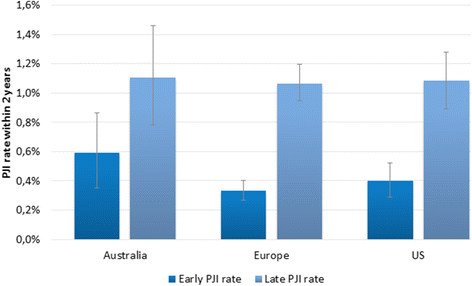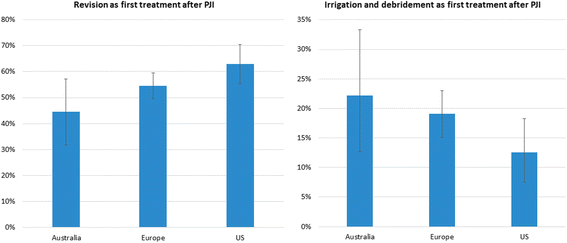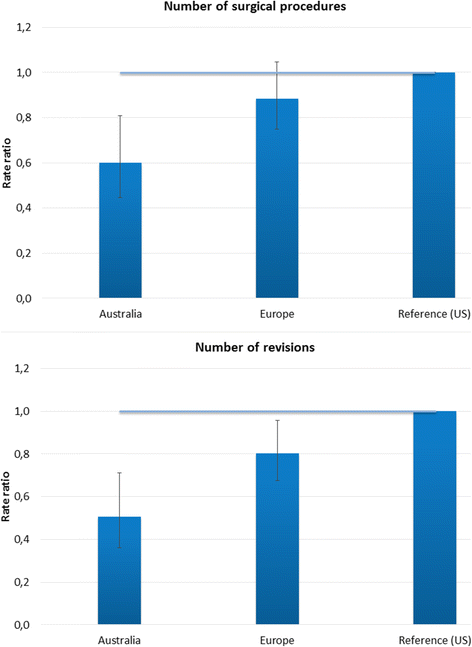Variation in Prosthetic Joint Infection and treatment strategies during 4.5 years of follow-up after primary joint arthroplasty using administrative data of 41397 patients across Australian, European and United States hospitals
- PMID: 28532409
- PMCID: PMC5441102
- DOI: 10.1186/s12891-017-1569-2
Variation in Prosthetic Joint Infection and treatment strategies during 4.5 years of follow-up after primary joint arthroplasty using administrative data of 41397 patients across Australian, European and United States hospitals
Abstract
Background: To identify best practices and quality improvement initiatives, we aimed to assess whether the incidence of Periprosthetic Joint Infection (PJI) and treatment strategies differed across patients treated in Australian, European and United States (US) hospitals.
Methods: Routinely collected administrative data for 41397 patients undergoing a primary total hip or knee arthroplasty between July 2007-December 2010 across 22 hospitals were included. Patients were followed for 2 years looking for PJI occurrence, defined as early (within 4 weeks) and late PJI, and surgical treatment during 2.5 years after PJI diagnosis. Logistic and Poisson regression models were used to test for differences in PJI occurrence and treatment strategies across the three geographical regions, adjusted for age, sex, joint and Elixhauser comorbidity groups.
Results: PJI occurrence varied from 1.4% in European to 1.7% in Australian patients, which were significantly higher than US patients after adjustment for patient characteristics (OR 1.24 [1.01-1.52] and 1.40 [1.03-1.91] respectively). Early PJIs varied between 0.3% in European to 0.6% in Australian patients, but adjusted rates were similar. Revision following PJI was significantly lower in Australian than in US patients (OR 0.46 [0.25-0.86]) as were the total number of revisions (RR 0.51 [0.36-0.71]) and number of surgical procedures (RR 0.60 [0.44-0.81]) used to treat PJI.
Conclusion: The overall PJI rate was significantly higher in Australian patients, but fewer procedures were needed to treat these PJIs. Future research should reveal whether this reflects PJIs caught earlier or less severe when diagnosed, and whether this is associated with the longer length of stay after primary arthroplasty in Australian hospitals.
Keywords: International variation; Periprosthetic Joint Infection; Total joint replacement; Treatment strategies.
Figures



References
-
- OECD. Hip and Knee replacement. In: Health at a Glance: Europe 2012. Paris: OECD publishing; 2012. pp. 86–7.
-
- Kurtz S, Ong K, Lau E, Mowat F, Halpern M. Projections of primary and revision hip and knee arthroplasty in the United States from 2005 to 2030. J Bone Joint Surg. 2007;89:780–5. - PubMed
Publication types
MeSH terms
LinkOut - more resources
Full Text Sources
Other Literature Sources
Medical

